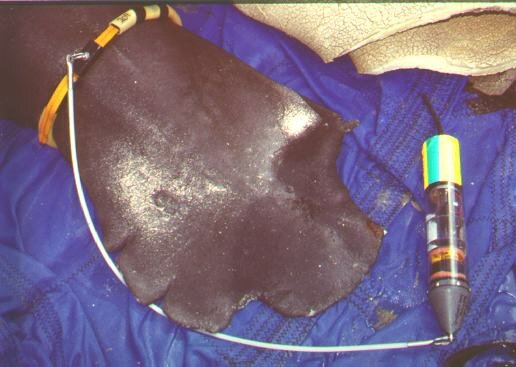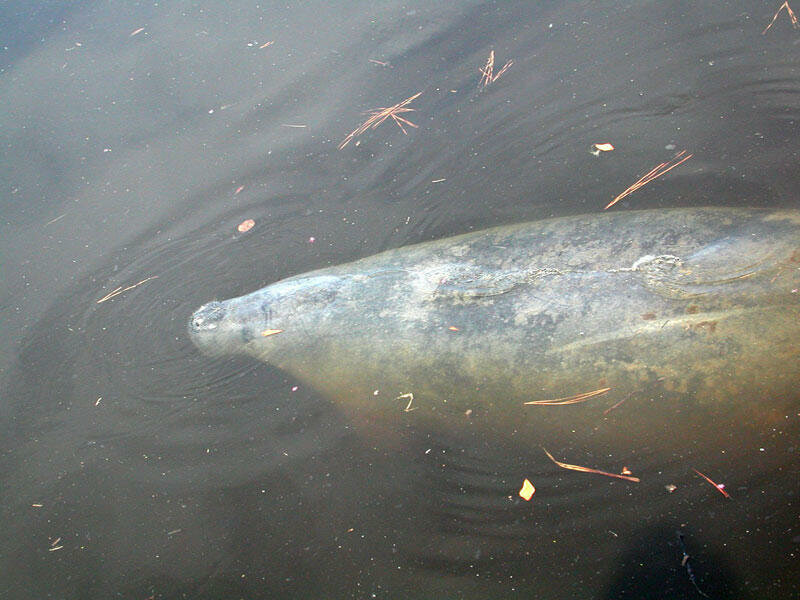Take It from Chessie the Manatee: You Can Help
In the fall of 1994, reports began to surface that a West Indian manatee was swimming in the Chesapeake Bay. The West Indian manatee is typically found in the warm waters of Florida and the Caribbean, much further south. Many observers were positive they saw a manatee in the region. Other people thought the observers must be crazy. Manatees had not been recorded in the Chesapeake Bay before.
By early fall a manatee was found in the Kent Narrows area of the Chesapeake Bay. Researchers became concerned about the welfare of this mammal. Manatees suffer negative health effects when water temperatures drop below 68 F. Winter was approaching, and water temperatures were dropping. Finally, officials from the Marine Animal Rescue Program at the National Aquarium worked with the U.S. Fish and Wildlife Service, SeaWorld Orlando and the Maryland Department of Natural Resources to rescue a manatee they named “Chessie.”
After a few days of TLC at the National Aquarium, Chessie was flown home to Florida courtesy of the U.S. Navy. Before releasing him into the wild, researchers from the U.S.G.S. Sirenia Project outfitted Chessie with telemetry gear to monitor his movements.
 Manatee telemetry device. Photo courtesy of Journey North.
Manatee telemetry device. Photo courtesy of Journey North.One year later, in 1995, researchers were shocked to discover Chessie was heading north again. This time Chessie bypassed the Chesapeake Bay and continued north to Judith Point, Rhode Island, before turning south and heading home before winter approached and water temperatures dropped.
Chessie was observed again in 2001 in Virginia and then 10 years later, in 2011 Chessie was seen in Maryland. Biologist Cathy Beck with the U.S. Geological Survey (USGS) matched photographs taken of the manatee in the Chesapeake Bay with Chessie’s photographic record in the USGS database. Chessie’s telltale markings include a long, gray scar on his left side. Chessie had returned to the Chesapeake Bay once again.
 A photograph of Chessie taken in 2001 shows a distinctive scar on his left side used to identify him.
A photograph of Chessie taken in 2001 shows a distinctive scar on his left side used to identify him.In 2021, Chessie was among many manatees rescued by the Florida Fish and Wildlife Conservation Commission during what is now called an “unusual mortality event.” Water pollution in Florida has killed much of the natural sea-grass beds in the state. Manatees are herbivores and depend on seagrass as their main food source. Chessie was one of many West Indian manatees starving to death in the state of Florida. Chessie spent three months in rehabilitation at SeaWorld Orlando before regaining his health and being released in North Palm Beach.
Because of Chessie’s curious nature and wanderlust tendencies along the East Coast, Clearwater Marine Aquarium (CMA) outfitted him with a GPS satellite tag before his last release. That was on January 25, 2022. On April 8, 2022, Chessie had lost all his tracking gear. Monitoring efforts were increased to assess if his thin body warranted a re-rescue. But without the tracking gear it became difficult to follow Chessie’s movements. Unable to locate Chessie after April 28, 2022, researchers at Clearwater Marine Aquarium along with the rest of us can only hope that Chessie has found ample food. And, that he is still swimming along the coast in warm waters.
Clearwater Marine Aquarium is a 501(c)(3) non-profit organization located in Clearwater, Florida. They believe in preserving our environment while inspiring the human spirit through leadership in the rescue, rehabilitation, and release of marine life; environmental education; research; and conservation.
CMA also supports North Atlantic right whale research and conservation programs. CMA Research Institute scientists have collected more than 20 years of aerial survey data on this species during calving season. CMA is also a sponsor for the Annual Right Whale Festival held on Amelia Island the first week of November each year.
Presently, water temperatures in our area are warm enough to invite manatees into the region. If you plan to enjoy a day boating on the water, use these helpful tips to keep you and the West Indian manatee safe this summer:
Call FWC’s Wildlife Alert toll-free number: 1-888-404-FWCC (1-888-404-3922) or #FWC or *FWC on a cellphone or text 847411 with keyword “FWC,” followed by the city and/or county and any information if you see a sick, injured, dead or tagged manatee.
Boaters will find them easier to spot if they wear polarized sunglasses and keep a lookout for signs of manatees such as the circular “footprints” they trace on the top of the water or their snouts sticking up out of the water.
Look, but don’t touch manatees. Keep your distance when boating, even if you are steering a canoe, kayak or paddleboard. Be a good role model for others so that they learn how to watch and enjoy manatees without disturbing the animals.
The plate you buy matters; support FWC manatee rescues and research. Next time you renew your tag, consider a “Save the Manatee” license plate.
Show your support for manatee conservation by proudly displaying a manatee decal. These high-quality stickers feature original artwork and are available from your local tax collector’s office with a $5 donation.






Comments
No comments on this item Please log in to comment by clicking here